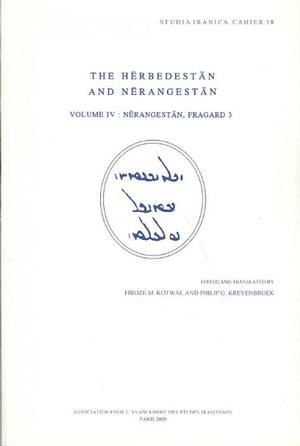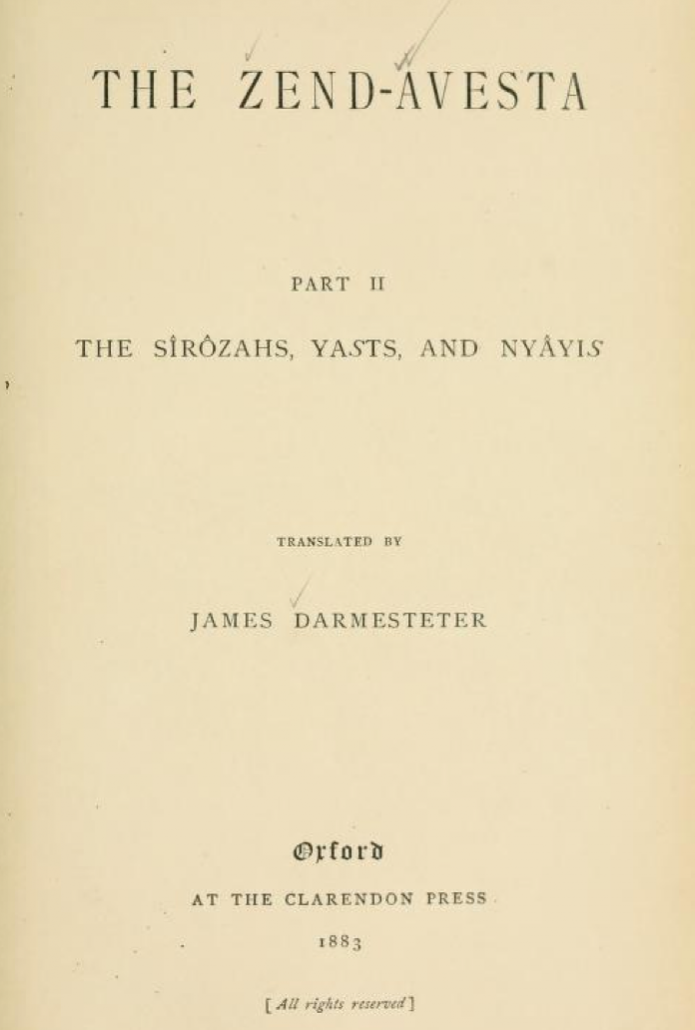The article below by Firoze M. Kotwal on Hêrbedestân is posted in the CAIS (Circle of Ancient Iranian Studies) venue but was originally published in the Encyclopedia Iranica on December 15, 2003 and last updated on March 22, 2012. This article is also available in print in the Encyclopedia Iranica (Vol. XII, Fasc. 3, pp. 227-228).
Kindly note that the pictures and accompanying captions describing these do not appear in the original postings of this article in the Encyclopedia Iranica and the CAIS venues.
=====================================================================
Hêrbedestân (school for priests, religious school), is a Middle Persian term designating (1) Zoroastrian priestly studies and (2) an Avestan/Pahlavi text found together with the Nêrangestân manuscripts.
The term hêrbedestân, which derives from Middle Persian hêrbed (q.v.), is generally translated as “courses of (advanced) priestly studies” or “religious studies.” It refers to courses of study offered by a priestly teacher (hêrbed). The evidence of the Zand î Wahman yasn (2.2-4) shows that, at least until the time of Sasanian Khosrow I Anôširavân (r. 531-79), attendance at the hêrbedestân was open to priesthood and laity alike. Advanced Zoroastrian priestly studies focused on the Pahlavi translation and exegesis of Avestan texts (Zand), which future scholar priests were required to study profoundly and in some cases to learn by heart. For lay people, on the other hand, such studies may have consisted essentially of listening to the explanations of the hêrbed (see Kotwal and Kreyenbroek, 1992, p. 17). Perhaps as a result of Mazdak’s revolt, Khosrow I found it necessary to bar the laity from studying the Zand, thus restricting attendance at the hêrbedestân to the priesthood.
 The Herbedestan and Nerangestan by Firoze M. Kotwal and Philip G. Kreyenbroek published by ISD in 2009 (Source: Strand Books).
The Herbedestan and Nerangestan by Firoze M. Kotwal and Philip G. Kreyenbroek published by ISD in 2009 (Source: Strand Books).
The text known as Hêrbedestân deals with the conditions affecting advanced priestly studies. Like the Nêrangestân and Vendidâd, the text appears to represent an ancient Zoroastrian learned, rather than liturgical, tradition. It was originally transmitted orally and committed to writing at an unknown date. Whereas liturgical texts were usually recited by at least two priests, who could check each other’s recitation, learned texts were taught by a single priestly teacher, whose mistakes were not corrected. This could result in a decline in the accuracy of the transmission; many Avestan passages in the Hêrbedestân are obviously corrupt.
The topics discussed in the Hêrbedestân are arranged in twenty chapters: The first chapter addresses the two questions of who shall go to do advanced priestly studies, and under what circumstances one may leave a piece of property that one is responsible for taking care of. The next chapter continues discussing the last topic and then addresses the questions of how far it is proper to travel, the relative merit of pursuing religious studies versus caring for one’s property, and the remuneration of the priestly teacher. The question of priestly studies versus care of property is resumed in the third chapter, followed by a comparison between the relative merit of pursuing religious studies and that of observing the rules for menstruation. Chapter 4 deals with the issue of how often and for how long should a person pursue religious studies. Chapter 5 is about female students and the women in charge of sacred fires. Chapter 6 is devoted to the question of female students, a question complicated by the fact that, in order to study under a priestly scholar, women must travel, which means that they need male escorts. Then the question arises as to which of the normal womanly duties she should perform for such a companion. The degrees of culpability incurred by a man who has illicit sexual intercourse with the woman he chaperones are discussed, as well as the respective responsibilities of the husband and the offending escort. The passage is followed by an aside on female nubility in general. Chapters 7-11 deal with the subject of accompanying a child to attend advanced priestly studies, and the responsibilities of the escort vis-a-vis the parents or legal guardians of the child. Chapter 12 is on the duration of the priestly studies and on those who are barred from them. It also discusses the situation of the wife and children of a man who converts to Zoroastrianism, of the estate of a deceased foreigner who has converted to the faith, and of a woman who dies shortly after embracing the faith. Relations between Zoroastrian men and non-Zoroastrian women as well as the case of non-Zoroastrians seeking refuge in Iran are also dealt with in this chapter. Chapter 13 is on learning how to recite the sacred texts, while the next four chapters focus on the teacher’s responsibilities (chaps. 14-15) and on valid and invalid reasons for failing to recite and study properly (chaps. 16-17). The remaining three chapters are about priestly teachers who are not good Zoroastrians (chap. 18), teaching those who are not good Zoroastrians (chap. 19), and feeding a non-Zoroastrian (chap. 20). The most important manuscripts are the 17th-century TD (see Kotwal and Boyd for a detailed survey of the MS tradition) and HJ, which had been copied in 1727 (ed. Sanjana).

James Darmesteter’s translation of the Zend-Avesta (Source: Archive.org).
James Darmesteter’s French translation of the Avestan part of the Hêrbedestân and Nêrangestân was published in 1893, followed by the English version of it in 1895. The year 1894 saw the publication of the Darab Peshotan Sanjana’s facsimile edition of HJ manuscript. The entire text was translated into English by Sohrab J. Bulsara in 1915. A German translation of the Avestan parts of both texts and their immediate Pahlavi renderings were published by Anatol Waag in 1941. After a long interval, the study of the Hêrbedestân was taken up again by Firoze M. Kotwal and James W. Boyd, who published a facsimile edition of TD manuscript in 1980. This was followed by a critical edition and translation of the text by Kotwal and Philip G. Kreyenbroek (with contributions by James R. Russell) in 1992. This had been preceded by Helmut Humbach and J. Elfenbein’s edition and translation of the same text in 1990.
Bibliography
Sohrab Jamshedjee Bulsara, tr., Aêrpatastan and Nirangestân: The Code of the Holy Doctorship and the Code of the Divine Service, Bombay, 1915.
James Darmesteter, Le Zend-Avesta, 3 vols., Paris 1892-93, repr., Paris, 1960.
Idem, The Zend Avesta, SBE 4, 2nd ed., New York, 1895. Bamanji Nasarvanji Dhabhar, ed., Pahlavi Yasna and Vispered, Bombay, 1949.
Helmut Humbach (in cooperation with Josef Elfenbein), ed. and tr., Ê, Münchener Studien zur Sprachwissenschaft, N.S. 15, Munich, 1990.
Firoze M. Kotwal and James W. Boyd, Ê, facs. ed. of the MS TD, Cambridge, Mass., and London, 1980.
Firoze M. Kotwal and Philip G. Kreyenbroek (with contributions by James Russell), eds. and trs., The Hêrbedestân and Nêrangestân I: Hêrbedestân, Studia Iranica, Cahier 10, Paris, 1992; II: Nêrangestân, Fragard 1, Studia Iranica, Cahier 16, Paris, 1995.
D. N. MacKenzie, A Concise Pahlavi Dictionary, London 1971. Darab Peshotan Sanjana, ed., Nirangistan, Photozincographed facs. ofa ms. Belonging to Hoshangjee Jamaspjee of Poona, Bombay, 1984.
Anatol Waag, Nirangestan: der Awestatraktat über die rituellen Vorschriften, Iranische Forschungen 2, Leipzig, 1941.
Zand î Wahman yasn, ed. and tr. Carlo G. Cereti as The Zand î Wahman Yasn: A Zoroastrian Apocalypse, Instituto italiano per il medio ed estremo orient, Serie orientale 75, Rome, 1995.



